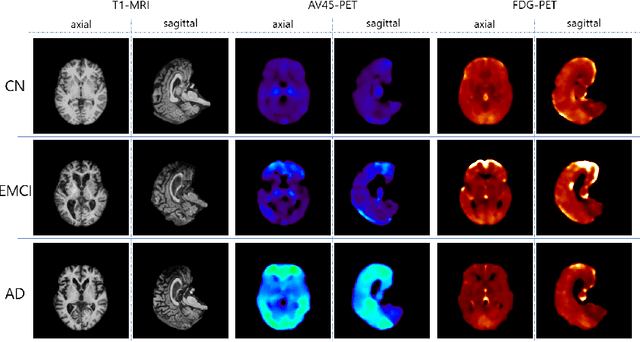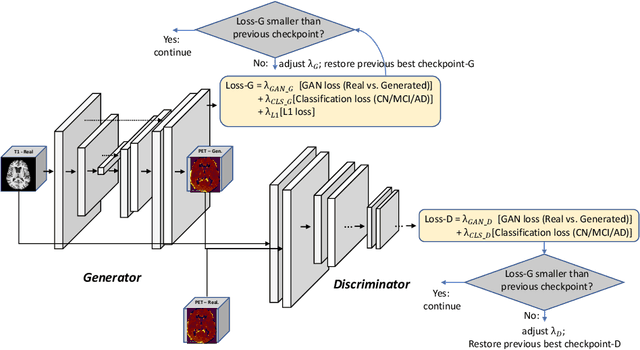Jiook Cha
Addressing the Current Challenges of Quantum Machine Learning through Multi-Chip Ensembles
May 13, 2025



Abstract:Quantum Machine Learning (QML) holds significant promise for solving computational challenges across diverse domains. However, its practical deployment is constrained by the limitations of noisy intermediate-scale quantum (NISQ) devices, including noise, limited scalability, and trainability issues in variational quantum circuits (VQCs). We introduce the multi-chip ensemble VQC framework, which partitions high-dimensional computations across smaller quantum chips to enhance scalability, trainability, and noise resilience. We show that this approach mitigates barren plateaus, reduces quantum error bias and variance, and maintains robust generalization through controlled entanglement. Designed to align with current and emerging quantum hardware, the framework demonstrates strong potential for enabling scalable QML on near-term devices, as validated by experiments on standard benchmark datasets (MNIST, FashionMNIST, CIFAR-10) and real world dataset (PhysioNet EEG).
Spatiotemporal Learning of Brain Dynamics from fMRI Using Frequency-Specific Multi-Band Attention for Cognitive and Psychiatric Applications
Mar 30, 2025



Abstract:Understanding how the brain's complex nonlinear dynamics give rise to adaptive cognition and behavior is a central challenge in neuroscience. These dynamics exhibit scale-free and multifractal properties, influencing the reconfiguration of neural networks. However, conventional neuroimaging models are constrained by linear and stationary assumptions, limiting their ability to capture these processes. Transformer-based architectures, known for capturing long-range dependencies, align well with the brain's hierarchical and temporal organization. We introduce Multi-Band Brain Net (MBBN), a transformer-based framework that models frequency-specific spatiotemporal brain dynamics from fMRI by integrating scale-free network principles with frequency-resolved multi-band self-attention. Trained on three large-scale neuroimaging cohorts (UK Biobank, ABCD, ABIDE) totaling 45,951 individuals, MBBN reveals previously undetectable frequency-dependent network interactions, shedding light on connectivity disruptions in psychiatric conditions (ADHD, ASD, depression). This validation shows robust generalizability and highlights core neural principles conserved across populations. MBBN achieves up to 30.59% higher predictive accuracy than state-of-the-art methods, demonstrating the advantage of frequency-informed spatiotemporal modeling in capturing latent neural computations. MBBN's interpretability uncovers novel frequency-specific biomarkers for neurodevelopmental disorders, providing insights into the hierarchical organization of brain function. By offering an interpretable framework for spatiotemporal learning, MBBN provides insights into how neural computations underpin cognitive function and psychiatric vulnerability, with implications for brain decoding, cognitive neuroscience, and precision psychiatry.
SEED: Towards More Accurate Semantic Evaluation for Visual Brain Decoding
Mar 09, 2025Abstract:We present SEED (\textbf{Se}mantic \textbf{E}valuation for Visual Brain \textbf{D}ecoding), a novel metric for evaluating the semantic decoding performance of visual brain decoding models. It integrates three complementary metrics, each capturing a different aspect of semantic similarity between images. Using carefully crowd-sourced human judgment data, we demonstrate that SEED achieves the highest alignment with human evaluations, outperforming other widely used metrics. Through the evaluation of existing visual brain decoding models, we further reveal that crucial information is often lost in translation, even in state-of-the-art models that achieve near-perfect scores on existing metrics. To facilitate further research, we open-source the human judgment data, encouraging the development of more advanced evaluation methods for brain decoding models. Additionally, we propose a novel loss function designed to enhance semantic decoding performance by leveraging the order of pairwise cosine similarity in CLIP image embeddings. This loss function is compatible with various existing methods and has been shown to consistently improve their semantic decoding performances when used for training, with respect to both existing metrics and SEED.
Mind the Gap: Aligning the Brain with Language Models Requires a Nonlinear and Multimodal Approach
Feb 18, 2025Abstract:Self-supervised language and audio models effectively predict brain responses to speech. However, traditional prediction models rely on linear mappings from unimodal features, despite the complex integration of auditory signals with linguistic and semantic information across widespread brain networks during speech comprehension. Here, we introduce a nonlinear, multimodal prediction model that combines audio and linguistic features from pre-trained models (e.g., LLAMA, Whisper). Our approach achieves a 17.2% and 17.9% improvement in prediction performance (unnormalized and normalized correlation) over traditional unimodal linear models, as well as a 7.7% and 14.4% improvement, respectively, over prior state-of-the-art models. These improvements represent a major step towards future robust in-silico testing and improved decoding performance. They also reveal how auditory and semantic information are fused in motor, somatosensory, and higher-level semantic regions, aligning with existing neurolinguistic theories. Overall, our work highlights the often neglected potential of nonlinear and multimodal approaches to brain modeling, paving the way for future studies to embrace these strategies in naturalistic neurolinguistics research.
Macro2Micro: Cross-modal Magnetic Resonance Imaging Synthesis Leveraging Multi-scale Brain Structures
Dec 15, 2024



Abstract:Spanning multiple scales-from macroscopic anatomy down to intricate microscopic architecture-the human brain exemplifies a complex system that demands integrated approaches to fully understand its complexity. Yet, mapping nonlinear relationships between these scales remains challenging due to technical limitations and the high cost of multimodal Magnetic Resonance Imaging (MRI) acquisition. Here, we introduce Macro2Micro, a deep learning framework that predicts brain microstructure from macrostructure using a Generative Adversarial Network (GAN). Grounded in the scale-free, self-similar nature of brain organization-where microscale information can be inferred from macroscale patterns-Macro2Micro explicitly encodes multiscale brain representations into distinct processing branches. To further enhance image fidelity and suppress artifacts, we propose a simple yet effective auxiliary discriminator and learning objective. Our results show that Macro2Micro faithfully translates T1-weighted MRIs into corresponding Fractional Anisotropy (FA) images, achieving a 6.8% improvement in the Structural Similarity Index Measure (SSIM) compared to previous methods, while preserving the individual neurobiological characteristics.
A Training-Free Approach for Music Style Transfer with Latent Diffusion Models
Nov 24, 2024



Abstract:Music style transfer, while offering exciting possibilities for personalized music generation, often requires extensive training or detailed textual descriptions. This paper introduces a novel training-free approach leveraging pre-trained Latent Diffusion Models (LDMs). By manipulating the self-attention features of the LDM, we effectively transfer the style of reference music onto content music without additional training. Our method achieves superior style transfer and melody preservation compared to existing methods. This work opens new creative avenues for personalized music generation.
Quantum Privacy Aggregation of Teacher Ensembles (QPATE) for Privacy-preserving Quantum Machine Learning
Jan 15, 2024



Abstract:The utility of machine learning has rapidly expanded in the last two decades and presents an ethical challenge. Papernot et. al. developed a technique, known as Private Aggregation of Teacher Ensembles (PATE) to enable federated learning in which multiple teacher models are trained on disjoint datasets. This study is the first to apply PATE to an ensemble of quantum neural networks (QNN) to pave a new way of ensuring privacy in quantum machine learning (QML) models.
AesFA: An Aesthetic Feature-Aware Arbitrary Neural Style Transfer
Dec 10, 2023



Abstract:Neural style transfer (NST) has evolved significantly in recent years. Yet, despite its rapid progress and advancement, existing NST methods either struggle to transfer aesthetic information from a style effectively or suffer from high computational costs and inefficiencies in feature disentanglement due to using pre-trained models. This work proposes a lightweight but effective model, AesFA -- Aesthetic Feature-Aware NST. The primary idea is to decompose the image via its frequencies to better disentangle aesthetic styles from the reference image while training the entire model in an end-to-end manner to exclude pre-trained models at inference completely. To improve the network's ability to extract more distinct representations and further enhance the stylization quality, this work introduces a new aesthetic feature: contrastive loss. Extensive experiments and ablations show the approach not only outperforms recent NST methods in terms of stylization quality, but it also achieves faster inference. Codes are available at https://github.com/Sooyyoungg/AesFA.
SwiFT: Swin 4D fMRI Transformer
Jul 12, 2023



Abstract:The modeling of spatiotemporal brain dynamics from high-dimensional data, such as 4D functional MRI, is a formidable task in neuroscience. To address this challenge, we present SwiFT (Swin 4D fMRI Transformer), a Swin Transformer architecture that can learn brain dynamics directly from 4D functional brain MRI data in a memory and computation-efficient manner. SwiFT achieves this by implementing a 4D window multi-head self-attention mechanism and absolute positional embeddings. We evaluate SwiFT using multiple largest-scale human functional brain imaging datasets in tasks such as predicting sex, age, and cognitive intelligence. Our experimental outcomes reveal that SwiFT consistently outperforms recent state-of-the-art models. To the best of our knowledge, SwiFT is the first Swin Transformer architecture that can process dimensional spatiotemporal brain functional data in an end-to-end fashion. Furthermore, due to the end-to-end learning capability, we also show that contrastive loss-based self-supervised pre-training of SwiFT is also feasible for achieving improved performance on a downstream task. We believe that our work holds substantial potential in facilitating scalable learning of functional brain imaging in neuroscience research by reducing the hurdles associated with applying Transformer models to high-dimensional fMRI.
GANDALF: Generative Adversarial Networks with Discriminator-Adaptive Loss Fine-tuning for Alzheimer's Disease Diagnosis from MRI
Aug 10, 2020



Abstract:Positron Emission Tomography (PET) is now regarded as the gold standard for the diagnosis of Alzheimer's Disease (AD). However, PET imaging can be prohibitive in terms of cost and planning, and is also among the imaging techniques with the highest dosage of radiation. Magnetic Resonance Imaging (MRI), in contrast, is more widely available and provides more flexibility when setting the desired image resolution. Unfortunately, the diagnosis of AD using MRI is difficult due to the very subtle physiological differences between healthy and AD subjects visible on MRI. As a result, many attempts have been made to synthesize PET images from MR images using generative adversarial networks (GANs) in the interest of enabling the diagnosis of AD from MR. Existing work on PET synthesis from MRI has largely focused on Conditional GANs, where MR images are used to generate PET images and subsequently used for AD diagnosis. There is no end-to-end training goal. This paper proposes an alternative approach to the aforementioned, where AD diagnosis is incorporated in the GAN training objective to achieve the best AD classification performance. Different GAN lossesare fine-tuned based on the discriminator performance, and the overall training is stabilized. The proposed network architecture and training regime show state-of-the-art performance for three- and four- class AD classification tasks.
 Add to Chrome
Add to Chrome Add to Firefox
Add to Firefox Add to Edge
Add to Edge